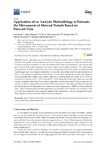Buscar
Mostrando ítems 1-8 de 8
Impact of Urban Growth and Changes in Land Use on River Flood Hazard in Villahermosa, Tabasco (Mexico)
(MDPI, 2019)
[Abstract:] The city of Villahermosa, a logistical center in the State of Tabasco’s economy, is affected by recurrent river floods. In this study, we analyzed the impact of two factors that are the most probable causes of ...
Dynamic calculation of breakwater crown walls under wave action: influence of soil mechanics and shape of the loading state
(MDPI, 2019)
[Abstract:] As a consequence of the action of waves on rubble mound breakwaters, there are loads—both on the vertical and horizontal sides of the crown walls—which modify the conditions of their stability. These loads ...
Effect of rainfall uncertainty on the performance of physically based rainfall–runoff models
(Wiley, 2019)
[Abstract:] This paper analyses the effect of rain data uncertainty on the performance of two hydrological models with different spatial structures: a semidistributed and a fully distributed model. The study is performed ...
Global and local sensitivity analysis to improve the understanding of physically-based urban wash-off models from high-resolution laboratory experiments
(Elsevier, 2019)
[Abstract:] Physically-based urban wash-off models are a promising means of studying the transport of finer suspended solids and their associated pollutants during rain events, considering spatial and temporal heterogeneities. ...
Application of an Analytic Methodology to Estimate the Movements of Moored Vessels Based on Forecast Data
(MDPI, 2019-09)
[Abstract]: A port’s operating capacity and the economic performance of its concessions are intimately related to the quality of its operational conditions. This paper presents an analytical methodology for estimating the ...
A rapid flood inundation model for hazard mapping based on least squares support vector machine regression
(Wiley, 2019)
[Abstract:] Two-dimensional shallow water models are widely used tools for flood inundation mapping. However, even if High Performance Computing techniques have greatly decreased the computational time needed to run a 2D ...
Using a 2D shallow water model to assess Large-Scale Particle Image Velocimetry (LSPIV) and Structure from Motion (SfM) techniques in a street-scale urban drainage physical model
(Elsevier, 2019)
[Abstract:] Physically-based numerical modelling of surface processes in urban drainage, such as pollutant wash-off or the assessment of flood risks, requires appropriate calibration and terrain elevation data to properly ...
Quantifying the role of individual flood drivers and their correlations in flooding of coastal river reaches
(Springer, 2019)
[Abstract:] Flooding in coastal river reaches is the result of complex interactions between coastal and inland drivers. Flood hazard assessments need to consider how these drivers interact in space and time, for which a ...













